AICAR transformylase/IMP cyclohydrolase (ATIC) is essential for de novo purine biosynthesis and infection by Cryptococcus neoformans.
Wizrah, M.S.I., Chua, S.M.H., Luo, Z., Manik, M.K., Pan, M., Whyte, J.M.L., Robertson, A.A.B., Kappler, U., Kobe, B., Fraser, J.A.(2022) J Biol Chem 298: 102453-102453
- PubMed: 36063996
- DOI: https://doi.org/10.1016/j.jbc.2022.102453
- Primary Citation of Related Structures:
7MGQ - PubMed Abstract:
The fungal pathogen Cryptococcus neoformans is a leading cause of meningoencephalitis in the immunocompromised. As current antifungal treatments are toxic to the host, costly, limited in their efficacy, and associated with drug resistance, there is an urgent need to identify vulnerabilities in fungal physiology to accelerate antifungal discovery efforts. Rational drug design was pioneered in de novo purine biosynthesis as the end products of the pathway, ATP and GTP, are essential for replication, transcription, and energy metabolism, and the same rationale applies when considering the pathway as an antifungal target. Here, we describe the identification and characterization of C. neoformans 5-aminoimidazole-4-carboxamide ribonucleotide (AICAR) transformylase/5'-inosine monophosphate cyclohydrolase (ATIC), a bifunctional enzyme that catalyzes the final two enzymatic steps in the formation of the first purine base inosine monophosphate. We demonstrate that mutants lacking the ATIC-encoding ADE16 gene are adenine and histidine auxotrophs that are unable to establish an infection in a murine model of virulence. In addition, our assays employing recombinantly expressed and purified C. neoformans ATIC enzyme revealed K m values for its substrates AICAR and 5-formyl-AICAR are 8-fold and 20-fold higher, respectively, than in the human ortholog. Subsequently, we performed crystallographic studies that enabled the determination of the first fungal ATIC protein structure, revealing a key serine-to-tyrosine substitution in the active site, which has the potential to assist the design of fungus-specific inhibitors. Overall, our results validate ATIC as a promising antifungal drug target.
Organizational Affiliation:
Australian Infectious Diseases Research Centre, University of Queensland, St Lucia, Queensland, Australia; School of Chemistry & Molecular Biosciences, University of Queensland, St Lucia, Queensland, Australia.















